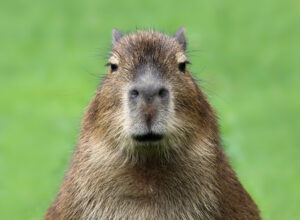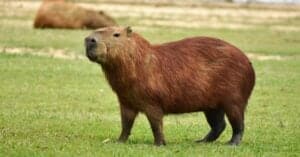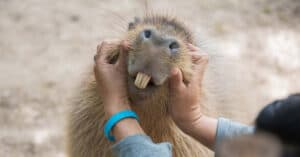With its playful and curious personality, the capybara has won the hearts of animal lovers from all corners of the globe. Capybaras are the world’s largest rodents and live in social groups, making them a fun addition to any experience with nature. These gentle giants from South America have been known to interact with humans in interesting ways, often begging for food or even participating in games of fetch. But as cute as these fuzzy brown critters are, have you ever wondered if there are any albino capybaras out there?
What is Albinism?

Albinism is caused by a gene mutation that affects the production of melanin.
©John Navajo/Shutterstock.com
Albinism is a rare condition that can affect all living things, including humans and animals of all backgrounds. This unique and remarkable condition is caused by a gene mutation that affects the production of melanin. This results in lighter-than-usual skin tones, hair, and eyes.
Melanin and carotenoids are both responsible for the coloring of the fur, eyes, and skin in humans and animals. Melanin is the pigment that gives us our natural skin color. Carotenoids are a type of yellow or orange pigment found in certain plants. In animals, these pigments help provide protection from harsh UV light. They also play a critical role in thermoregulation by absorbing energy and helping to keep the animal cool or warm in extreme temperatures.
Since albino animals and humans lack melanin, they often have white or very light-colored hair or skin. However, while albinism in animals can significantly reduce the amount of melanin present, the body may still contain some carotenoids. That is why albino animals have white hair or fur, but often have a yellow-tinged or pinkish appearance, and their eyes are red or pink.
Depending on the type and severity of the mutation, animals with albinism may display different levels of pigment reduction in their fur, eyes, and skin. It is also possible for certain species to have patches of albino fur amongst normally-pigmented fur. While they may look different, with the right care and support, animals with albinism can live happy and healthy lives. Whether they’re cats, dogs, or birds, they can lead wonderful and productive lives in the right environment.
Are There Albino Capybaras?
Although they are extremely rare, there have been a few documented cases of albino capybaras. In 2009, for example, the M’Bopicua Breeding Station in Uruguay received a very special Christmas surprise: two adorable baby capybaras were born that day, but one of them was pure white! This rare albino capybara was given the name “Blancanieves,” or Snow White.
As an albino, Blancanieves’ body did not produce the pigment that gives normal capybaras their brownish color, even though both of her parents were brown. In addition, because albinism is recessive, it’s impossible to know if her siblings had two normal-colored genes or one normal gene and one albino gene.
Albinism is always recessive because an albino animal or person is missing the gene necessary to make the pigment. But since there are two copies of every gene, if Blancanieves ever had babies with a normal-colored capybara, all of their offspring would be the regular brownish, capybara color.
These babies would have one broken copy of the gene from Blancanieves and one working copy from their normal-colored father — a situation geneticists call heterozygous. The working copy should make enough pigment for all of her babies to be brown, just like their father. However, it’s also possible they could be a slightly lighter color as well.
Albino Capybaras in the Wild
Although there have been sightings of albino capybaras in the wild, these are extremely rare. Albino capybaras are more than just a rare sight, however — they also face several unique challenges.
Albinism causes a capybara to have poor vision due to a lack of pigment in their eyes, making it difficult for them to navigate the world around them. They can also experience higher levels of glare, making it harder for them to see properly in certain lighting conditions.
Additionally, their white fur makes it easy for predators to spot them, leaving them vulnerable to attack. The lack of pigmentation in their fur also affects their ability to stay warm during cold weather. In addition, albino animals do not have the same protection against ultraviolet rays that normal animals do, they can suffer from sunburns more easily.
All of these physical difficulties can make life challenging for albino capybaras, but with careful management and attention from conservationists, these remarkable creatures will continue to captivate us all.
Up Next:
- Are Capybaras the Biggest Rodents in the World?
- 10 Incredible Capybara Facts
- What Is a Group of Capybaras Called and How Do They Behave?
- Even When Capybaras Fight They’re Still Completely Adorable
The photo featured at the top of this post is © Giedriius/Shutterstock.com
Thank you for reading! Have some feedback for us? Contact the AZ Animals editorial team.






